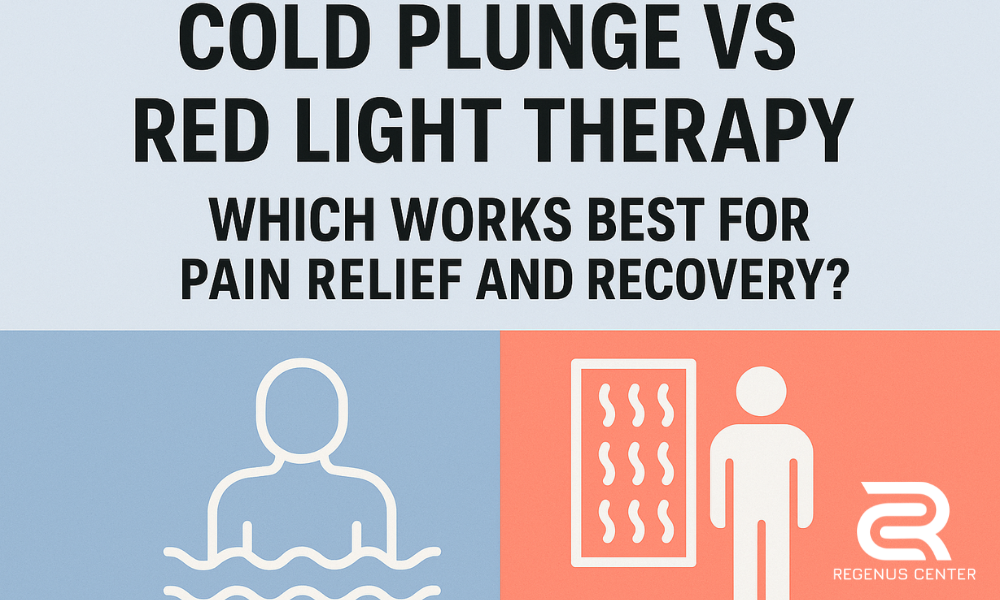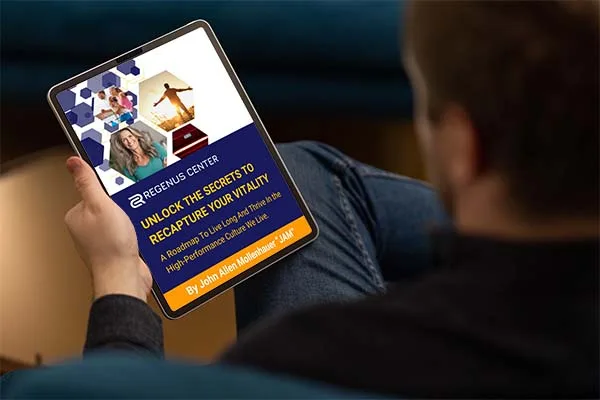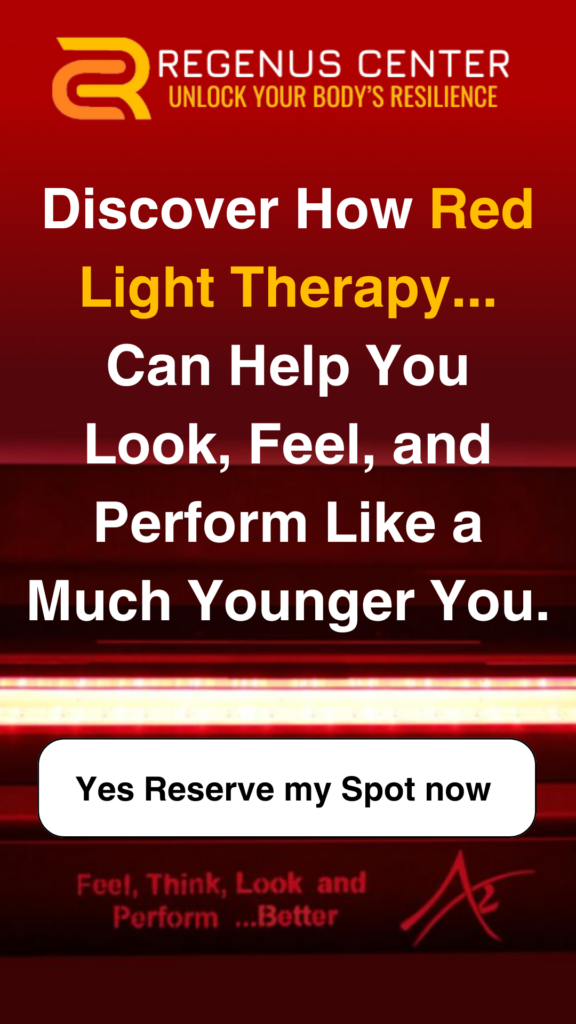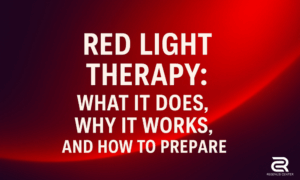Cold Plunge vs Red Light Therapy: Which Works Best for Pain Relief and Recovery?
When I was first getting into this business, I thought I might be getting into the Cryotherapy business, since that’s what these types of centers were called in those days. But I quickly realized that the kind of business I was getting into—and how it would be defined and named—would come down to the very title of this article.
I also knew intuitively that this decision would impact our BioVitality Protocol and how we would ultimately set up our center. Because it’s not just about offering “trendy” modalities; it’s about asking the hard question people really care about: Which one works best for pain relief and recovery?
So let’s dive in.
Understanding the Science Behind Each Modality
Cold Plunge (Cryotherapy / Cold Water Immersion)
Cold plunges have been used for centuries, but the science today backs what athletes and wellness practitioners have long believed: cold water immersion reduces pain, inflammation, and soreness by constricting blood vessels, lowering tissue temperature, and calming the nervous system (1).
It also stimulates norepinephrine—a neurotransmitter that sharpens focus and reduces pain perception—explaining the mental “reset” so many describe after plunging (2).
But here’s the nuance:
-
If your goal is soreness relief and faster recovery, cold plunging within 30 minutes post-exercise works best. Studies show reduced delayed-onset muscle soreness (DOMS) and improved recovery markers within 24–48 hours (1).
-
If your goal is building muscle size and strength, research shows that cold water immersion immediately after lifting can blunt hypertrophy by reducing protein synthesis (3). In that case, it’s better to wait at least 4 hours before plunging.
👉 According to neuroscientist Dr. Andrew Huberman, you should actually wait at least 4 to 6 hours after weightlifting before taking an ice bath or cold plunge if your primary goal is muscle hypertrophy. He notes that waiting 6 to 8 hours is even better. The reason is that cold exposure is strongly anti-inflammatory, yet the inflammation that occurs right after resistance training is part of the signaling cascade that builds muscle. By cooling down too soon, you risk muting those anabolic signals (8).
Here’s how Huberman frames it:
-
For muscle growth: Postpone cold exposure for 4–6 hours (ideally 6–8).
-
For endurance training: Cold plunges right after can reduce soreness and speed recovery.
-
For general recovery: If soreness relief is the goal, cold water immersion soon after training is fine.
-
On rest days: Safe anytime—you’ll get the metabolic and mental benefits without interfering with gains.
-
Before a workout: Cold plunges aren’t a problem for hypertrophy and may boost focus and adrenaline.
-
For a lighter touch: Cold showers are less disruptive to muscle-building than full immersion.
So cold therapy is a phenomenal tool—use it strategically depending on your objective.
Red Light Therapy (Photobiomodulation)
Red light therapy takes a different path. Instead of shocking the system, it uses wavelengths of red and near-infrared light (600–1000 nm) to penetrate tissue up to 2–3 cm. This light stimulates mitochondria—the power plants of your cells—to produce more ATP, fueling repair and regeneration (4).
Clinical studies back this up. In patients with knee osteoarthritis, red light therapy reduced pain scores by as much as 40% compared to placebo (5). Other trials show accelerated wound healing, reduced inflammation, and improved circulation (6).
Unlike the cold plunge, which impacts the body systemically, red light works precisely at the site of injury or pain. It’s localized healing power.
Cold Plunge vs Red Light Therapy: Head-to-Head
| Therapy | What It Does | Best For | Considerations |
|---|---|---|---|
| Cold Plunge | Reduces inflammation, boosts norepinephrine, and systemic reset | Post-exercise soreness, stress relief, resilience | Wait 4–6+ hrs if hypertrophy/strength is your main goal |
| Red Light Therapy | Enhances cellular energy, reduces inflammation, accelerates healing | Joint/muscle pain, arthritis, tissue recovery | Works best with consistent, repeated sessions |
Why Combining Both Therapies Works
One of the most exciting insights we’ve seen at Regenus Center is the synergy of combining these therapies. Cold plunges reset the nervous system and reduce inflammation, while red light therapy accelerates healing at the cellular level.
A study in the Journal of Athletic Training found that combining photobiomodulation with cold immersion produced better recovery outcomes than either alone (7). That’s why both are pillars of our BioVitality Protocol.
How Locals in Morris County Can Choose the Right Therapy
If you’re here in Morris County—whether in Morristown, Parsippany, Chatham, or East Hanover—here’s how I’d guide you:
-
Know Your Pain & Your Goal
-
Muscle soreness or systemic fatigue → Cold plunge (within 30 min post-workout).
-
Localized joint pain, chronic inflammation, or tissue repair → Red light therapy.
-
Building muscle size/strength → Use cold plunge later (after 4–6 hours).
-
-
Think About Lifestyle Fit
-
Cold plunges often require equipment or a facility.
-
Red light is easier to integrate consistently at home or in-center.
-
-
Start Simple, Then Stack
-
Begin with the one you’ll stick with.
-
For maximum effect, combine them strategically—plunge to reset, red light to repair.
-
My Takeaway
The answer to “Which works best?” isn’t either/or—it’s about timing, goals, and context.
-
Cold plunge is unbeatable for systemic reset, inflammation control, and resilience.
-
Red light therapy is unmatched for localized, cellular-level pain relief and recovery.
-
Together, they’re a powerhouse—exactly why we built our BioVitality Protocol at Regenus Center.
If you’re in Morris County and ready to get out of pain and back into life, don’t ask “Which is better?” Instead, ask: What do I need most right now?
That shift in thinking is how recovery becomes a lifestyle—not just a one-off session.
Final Word
So, what’s the right way to go—cold plunge or red light therapy for pain relief and recovery?
The truth is, both are powerful tools, and the answer depends on your goals. If you’re looking for fast soreness relief and a full-body reset, the cold plunge delivers. If your focus is localized pain, joint issues, or deeper tissue recovery, red light therapy shines. And when you combine them strategically, you get the best of both worlds—systemic resilience and cellular repair.
At Regenus Center in East Hanover, we’ve built our BioVitality Protocol around this exact approach—helping you know when to plunge, when to shine, and how to recover in a way that fits your lifestyle.
FAQs
Q: Is it better to do a cold plunge or red light therapy after exercise for soreness relief?
A: If your main goal is soreness relief, a cold plunge within 30 minutes after exercise works best because it reduces inflammation and muscle soreness quickly. If you’re targeting joint pain or localized inflammation, red light therapy is more effective because it stimulates cellular repair. Many people combine both for optimal recovery.
Q: How long should I wait after lifting before doing a cold plunge if I want to build muscle?
A: If muscle growth and strength gains are your main goals, wait at least 4 to 6 hours before plunging. Research shows cold exposure immediately after strength training can blunt protein synthesis and reduce hypertrophy gains. On non-lifting days, cold plunges can be used anytime for recovery and stress relief.
Q: Can you combine cold plunge and red light therapy for pain relief and recovery?
A: Yes. Cold plunge gives a systemic reset, reduces inflammation, and improves mood, while red light therapy boosts energy production at the cellular level and helps with tissue repair. Using them back-to-back—plunge first, then red light—can deliver both immediate soreness relief and long-term recovery benefits.
References
-
Bleakley CM, et al. Cold-water immersion (cryotherapy) for preventing and treating muscle soreness after exercise. Cochrane Database Syst Rev. 2012.
-
Huttunen P, et al. Endorphins and norepinephrine release after cold exposure. Med Hypotheses. 2001.
-
Roberts LA, et al. Post-exercise cold water immersion attenuates acute anabolic signaling and long-term adaptations in muscle to strength training. J Physiol. 2015.
-
Hamblin MR. Mechanisms of photobiomodulation. Photochem Photobiol. 2016.
-
Brosseau L, et al. Low level laser therapy (red light) for osteoarthritis and joint pain. Cochrane Database Syst Rev. 2007.
-
Leal-Junior ECP, et al. Photobiomodulation therapy in exercise performance and recovery: from mechanisms to clinical practice. J Biophotonics. 2019.
-
Ferraresi C, et al. Combination of cryotherapy and photobiomodulation improves recovery in athletes. J Athl Train. 2016.
-
Huberman A. Using Deliberate Cold Exposure for Health and Performance. Huberman Lab Podcast, Episode 66, 2022. Available at: https://hubermanlab.com





